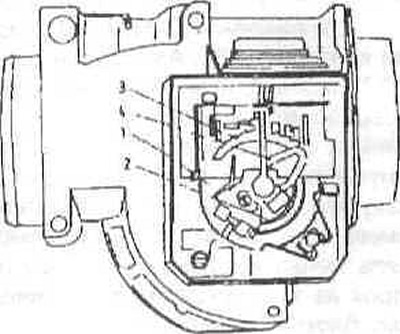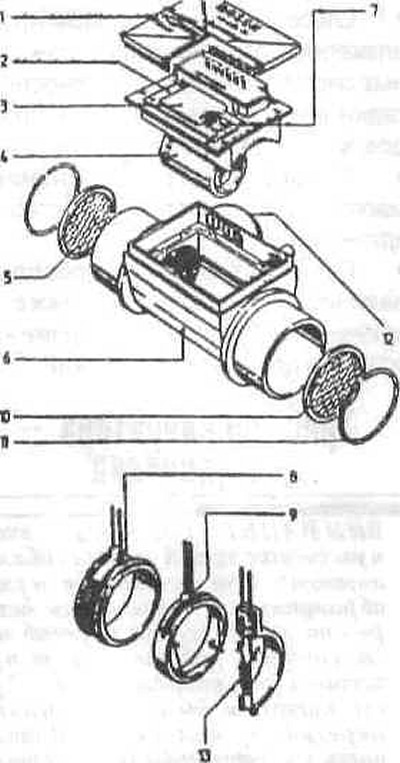
Air mass meter of early car models
1 - ring gear;
2 - return spring;
3 - sliding contact comb;
4 - sliding contact of the potentiometer.
In the case of the air flow meter there is a damper that deviates when air passes through it at a certain angle. The angle of the damper is a measure of the amount of air passing through.

Late model air mass meter
1 - cover;
2 - main board;
3 - switch;
4 - inner pipe;
5 - protective grille;
6 - body;
7 - powerful buffer transistor;
8 - measuring resistance;
9 - element with incandescent wire;
10 - protective mesh;
11 - retaining ring;
12 - connector;
13 - temperature compensation resistance.
Air is drawn in by the engine through the air filter and passes through the hot mesh air mass meter (late car models). The air flow meter contains a thin electrically heated plate which is cooled by the passing air. An electronic control regulates the heating current so that the temperature of the plate remains constant. If, for example, the amount of incoming air increases, then the heated plate will tend to cool down. Because of this, the heating current immediately increases so that the temperature remains the same. The DME determines the motor load from fluctuations in the heating current.
The control unit, in accordance with the amount of air and the engine speed, controls the injection time and, accordingly, the amount of injected fuel. With a longer opening of the nozzle, more fuel is injected. Additional devices and sensors also provide an accurate determination of the amount of fuel in extreme situations.
Fuel injection is carried out sequentially. This means that the injectors are individually controlled and inject fuel according to the firing order to the engine intake valves. Thanks to the selection of the injection moment and the duration of the opening of the nozzles, the power and toxicity of the engine exhaust gases can be precisely controlled. The engine responds very quickly to the pedal «gas».
The throttle potentiometer is located directly on the throttle shaft. It tells the control unit the actual throttle position. Thanks to this, the engine braking mode is controlled, i.e. when the throttle valve closes and at the same time the speed reaches a certain value, the control unit stops the fuel supply to the engine.
The fuel pump relay is located in the relay box behind the left front suspension strut. It supplies voltage to the fuel pump. The safety circuit interrupts the power supply when the engine is not running, for example when it stops unexpectedly.
The instantaneous position of the engine crankshaft and the number of its revolutions are determined by two inductive sensors: the sensor for the number of revolutions and the position of the reference mark is located on the crankshaft pulley. The cylinder identification sensor is located on the front of the engine in the timing chain cover. Two lambda probes measure the oxygen content in the exhaust stream and send the corresponding voltage signals to the control unit. By analyzing the signals, the control unit changes the air/fuel ratio so that the exhaust gases are optimally afterburned in the catalytic converter.
The idle speed control controls the amount of air at idle that bypasses the throttle. This achieves a stable idle speed, no matter how much additional load, such as power steering or air conditioning compressor, is currently connected.
The solenoid valve for fuel tank ventilation is controlled depending on the engine operating mode. Fuel vapors in the tank are collected in an activated carbon filter and fed to the engine for afterburning through a valve. Thus, due to the filter, fuel vapors are mostly used usefully and do not enter the atmosphere.
The camshaft-assisted variable valve timing system, referred to as VANOS for short, rotates the intake camshaft depending on engine speed and engine load by engine oil pressure relative to the drive sprocket in such a way that optimal valve timing is achieved in terms of idling comfort, torque and fuel consumption. The DME controls the oil supply to the actuator via an electrically controlled valve.
The high voltage control system turns off the DME if it is too low (for example, in case of damage to high-voltage wires), and the engine cannot be started. This prevents damage to the catalyst.
Management of other control systems (ABS, ASC, transmission control) produced by CAN, a special data processing system. Among other things, the advantage of this system is that the engine wiring harness has fewer wires, and the car is less prone to failure due to malfunctions of individual control units.
